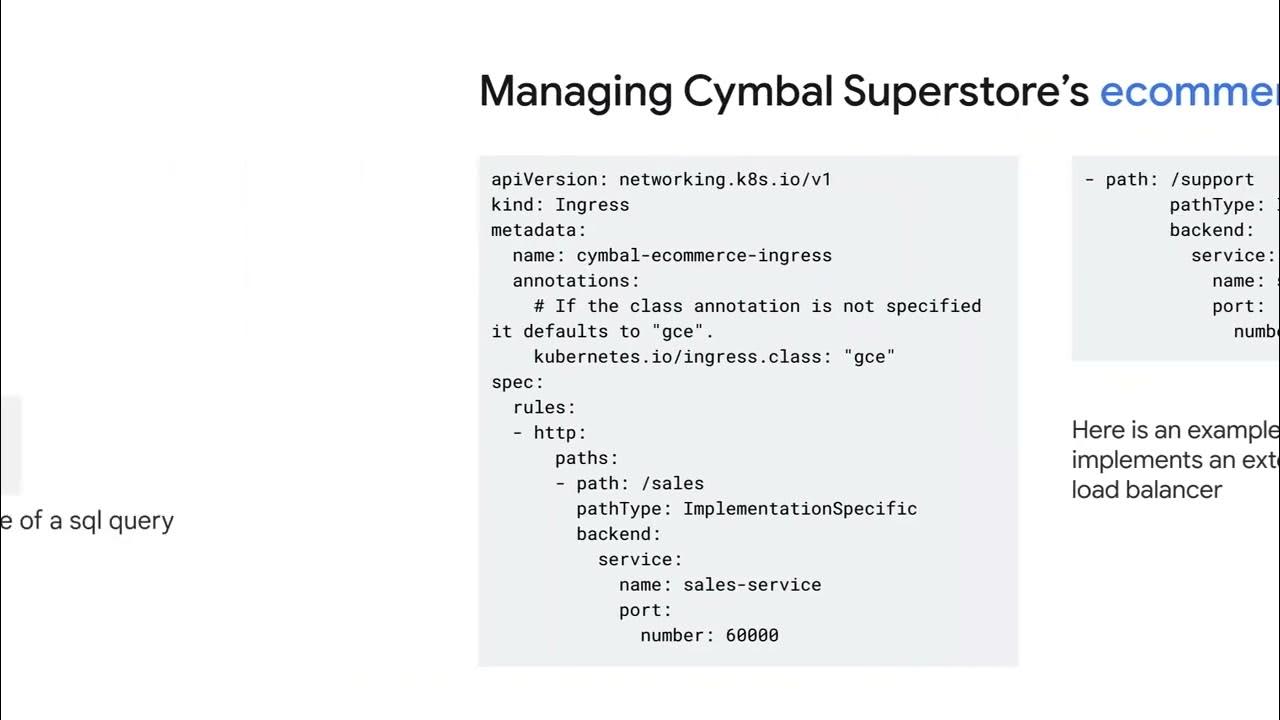Deploying and implementing Cymbal Superstore’s cloud recommended solutions
Summary
TLDRThe video highlights the responsibilities of an associate cloud engineer, focusing on deploying and implementing Google Cloud solutions. It emphasizes key services like Compute Engine, Kubernetes Engine, Cloud Functions, and Cloud SQL. The video also covers the importance of Google Cloud data solutions, network configurations, and tools like Cloud Marketplace. It uses Cymbal Superstore's eCommerce, transportation, and supply chain solutions as examples, showing how to manage resources using Google Cloud Console, command line, and infrastructure-as-code practices for efficient deployment and management.
Takeaways
- 🚀 You've successfully planned and configured cloud solutions for Cymbal Superstore's application requirements.
- 🛠 Solution deployment is critical, and as an associate cloud engineer, you're expected to implement specific compute solutions such as Compute Engine, Kubernetes Engine, Cloud Run, and Cloud Functions.
- 📊 Google Cloud provides data solutions like Spanner and BigQuery for scalable, transactional, and analytical use cases.
- 🔒 Proper implementation of software-defined networking ensures secure and accessible front-end and back-end application components.
- 🛍️ Cloud Marketplace simplifies the deployment of pre-built software stacks, reducing the need for custom builds.
- 🖥️ Infrastructure as code, with source-controlled configuration files, is a best practice for reducing human error and speeding up resource deployment.
- 📦 Cymbal Superstore's Ecommerce solution is based on Kubernetes Engine, Spanner, and external HTTPS load balancing, with BigQuery for sales data analysis.
- 🚚 The transportation management system uses Pub/Sub, Cloud Functions, and Dataflow to process sensor data and store it in Bigtable.
- 🔗 The supply chain app relies on managed instance groups in Compute Engine, with Cloud SQL for the backend and TCP internal VPC connectivity.
- 💻 You can interact with Google Cloud via the Cloud Console, command line interface (CLI), or programmatically, depending on your deployment needs.
Q & A
What are some key tasks of an associate cloud engineer in the context of solution deployment?
-An associate cloud engineer is responsible for deploying and implementing compute solutions such as Compute Engine, Kubernetes Engine, Cloud Run, and Cloud Functions. They also need to understand availability, concurrency, connectivity, and access options for these services.
What are Google Cloud's data solutions used for?
-Google Cloud offers data solutions that use both relational and NoSQL data structures. These solutions support transactional and analytical use cases, with some optimized for low latency and global availability.
Why is using Cloud Marketplace beneficial for setting up Compute Engine instances?
-Cloud Marketplace provides pre-configured software stacks, allowing developers to quickly deploy frameworks without reinventing the wheel. This can significantly speed up the development or production setup.
What is a common DevOps practice when deploying infrastructure, and why is it important?
-A common DevOps practice is deploying infrastructure using Infrastructure as Code (IaC) in a declarative way and storing configuration files in source control. This reduces human error and speeds up resource allocation.
What is Cymbal Superstore's proposed solution for their Ecommerce application?
-Cymbal Superstore's Ecommerce solution is based on Google Kubernetes Engine for container management, Cloud Spanner for a globally available data store, external HTTPS load balancing for user access, and BigQuery for analyzing historical sales data.
How does the transportation management system handle sensor data in Cymbal Superstore's solution?
-The transportation management system uses Pub/Sub to monitor incoming sensor data. When new messages are posted to a specific topic, a Cloud Function is triggered, which starts a Dataflow job to transform the data and save it in Bigtable.
What back-end architecture is used for the supply chain application?
-The supply chain application uses managed instance groups in Compute Engine for its backend, with Cloud SQL as the back-end store. Connectivity between the Compute Engine instances and Cloud SQL is via TCP internal to the VPC, with external access provided by a regional HTTPS load balancer.
What are three ways to interact with Google Cloud to deploy services?
-Three ways to interact with Google Cloud to deploy services are through the Google Cloud Console, the command line interface (CLI), and programmatically using SDKs or APIs.
What is the role of Cloud Functions in Cymbal Superstore's transportation management system?
-Cloud Functions are used to deploy function code that is triggered by Pub/Sub events. The function processes sensor data messages and initiates further actions like starting a Dataflow job for data transformation.
How can you deploy a compute instance for Cymbal Superstore's development team using Google Cloud Console?
-To deploy a compute instance via Google Cloud Console, you need to specify settings such as the instance name, region, zone, machine configuration, boot disk, network settings, and any persistent disks you want to attach to the virtual machine.
Outlines

This section is available to paid users only. Please upgrade to access this part.
Upgrade NowMindmap

This section is available to paid users only. Please upgrade to access this part.
Upgrade NowKeywords

This section is available to paid users only. Please upgrade to access this part.
Upgrade NowHighlights

This section is available to paid users only. Please upgrade to access this part.
Upgrade NowTranscripts

This section is available to paid users only. Please upgrade to access this part.
Upgrade NowBrowse More Related Video

Introduction to the Associate Cloud Engineer role

Managing Cymbal Superstore’s cloud solutions

Managing access for Cymbal Superstore’s cloud solutions

Certification value and benefits

اشتغل Cloud ولا DevOps Engineer ? وايه الفرق ما بينهم ؟ | Cloud vs DevOps Engineer

Keynote: Future of Networks: AI-Driven Network Transformation - Ankur Jain & Kandan Kathirvel
5.0 / 5 (0 votes)